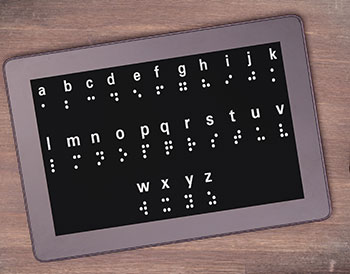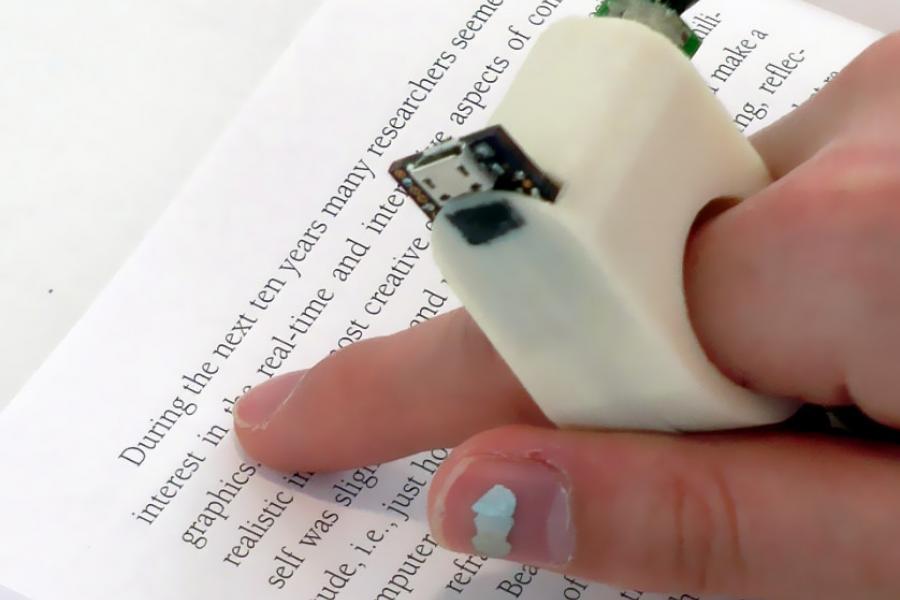OCR Devices for the Blind: Converting Text into Speech with Ease
Wiki Article
Discover Ingenious Tools Created for the Aesthetically Damaged
The growth of ingenious devices for the aesthetically impaired represents a considerable improvement in access and self-reliance. Technologies such as wise glasses with AI capacities and mobile applications developed to provide acoustic descriptions are reshaping everyday experiences for customers. Additionally, wearable gadgets that use haptic feedback improve ecological understanding, while contemporary Braille developments use new methods to involve with text. As these devices proceed to develop, their influence on the lives of those with aesthetic disabilities increases vital questions regarding the future of inclusivity and autonomy in numerous facets of life. What exists in advance in this technological landscape?Smart Glasses for Navigating

Smart glasses developed for navigating are transforming the method visually damaged people communicate with their environment. These sophisticated gadgets make use of a mix of video camera technology, expert system, and auditory responses to supply real-time details concerning surroundings. By using barrier detection systems, smart glasses can inform users to prospective threats, making it possible for much safer wheelchair in both acquainted and unfamiliar setups.
The combination of GPS innovation better improves navigating abilities, allowing customers to obtain auditory instructions as they relocate. This hands-free strategy not just promotes self-reliance however likewise empowers visually impaired people to browse metropolitan landscapes with enhanced confidence. Furthermore, lots of wise glasses are geared up with features that recognize sites and street indicators, providing contextual details that boosts the individual experience.
Furthermore, the development of these tools is continuously advancing, with companies functioning to improve the precision of item recognition and increase the variety of navigational features. As clever glasses end up being much more economical and accessible, they hold the possible to significantly change life for visually impaired customers. Eventually, these cutting-edge devices represent an essential step towards inclusivity, offering enhanced flexibility and a higher feeling of freedom for people browsing the world around them.

Mobile Apps for Daily Living
Just how can mobile applications boost the every day lives of visually impaired people? Mobile apps are reinventing the method visually damaged individuals navigate their settings, handle day-to-day jobs, and access info. These applications supply crucial assistance through numerous performances, cultivating freedom and enhancing high quality of life.Numerous innovative mobile apps are designed especially for everyday living. For instance, applications like Be My Eyes link visually damaged users with sighted volunteers using video clip phone calls, permitting them to receive real-time assistance with tasks such as reading labels or browsing unfamiliar rooms. Similarly, Seeing AI, developed by Microsoft, uses fabricated intelligence to define surroundings, read text, and identify objects, properly transforming a smart device into an effective tool for day-to-day assistance.
Furthermore, navigating apps tailored for the visually damaged, such as Aira and BlindSquare, supply audio-based instructions and ecological information, enabling individuals to traverse their surroundings securely and with confidence. Past navigating and immediate assistance, mobile applications additionally support organization and job administration, with features that assist individuals establish reminders, develop order of business, and track visits. In summary, mobile applications function as important sources, equipping visually impaired people to lead even more independent and satisfying lives.
Wearable Technologies for Support
Empowerment through innovation is increasingly apparent in the realm of wearable tools made to assist aesthetically impaired people. These innovative tools integrate perfectly into day-to-day live, enhancing navigation and providing important responses to customers. As an example, clever glasses equipped with electronic cameras can check out and recognize faces message aloud, permitting individuals to connect more with confidence in social and expert settings.One more notable innovation is making use of haptic comments systems in wearable tools. These systems use resonances or various other responsive signals to communicate information about the customer's environment, such as challenges or adjustments in terrain, boosting flexibility and safety. Wearable technologies also consist of wristbands that connect to smartphones, notifying users to alerts via subtle vibrations, therefore enhancing connectivity without reliance on visual hints.
As these technologies continue to progress, they are not just boosting freedom for aesthetically impaired people however likewise fostering a better feeling of incorporation in culture. By bridging the gap in between difficulties dealt with in day-to-day living and the possibility for freedom, wearable technologies work as crucial tools in the quest for equality and empowerment for those with aesthetic problems.
Audio Summary Tools
Sound summary tools play a vital role in enhancing availability for visually impaired people, giving them with the capability to involve with aesthetic media. Screen readers for the blind. These tools offer narrated descriptions of key visual Braille displays and notetakers aspects in films, television shows, and live performances, guaranteeing that individuals can completely comprehend the context and emotions conveyed through visualsSound summary can be incorporated right into different platforms, including streaming services, cinema screenings, and live cinema. Several preferred streaming solutions now include audio summary as an ease of access feature, allowing viewers to pick it quickly. In addition to mainstream media, specialized apps additionally exist, providing audio descriptions for art events, galleries, and other social occasions.
The effectiveness of audio description rests on the skill of the narrators, that have to convey aesthetic details succinctly without detracting from the initial audio. Developments in this area are likewise leading the way for even more customized experiences, where users can adjust the level of information and pacing according to their preferences.
Braille Innovations and Instruments
Braille advancements and devices have actually significantly changed the method visually impaired people connect with text and information. Modern developments have led to the advancement of functional devices that boost proficiency and freedom amongst users. Significantly, Braille display technologies have actually developed, enabling dynamic reading experiences. These gadgets transform electronic text into Braille, allowing individuals to access a huge array of info on tablet computers, mobile phones, and computer systems.
Moreover, portable Braille notetakers combine typical Braille input with contemporary functionalities, helping with note-taking, organizing, and file editing and enhancing on the move. Mobility aids for visually impaired users. These small devices typically include text-to-speech abilities, connecting the gap in between Braille and acoustic information
Additionally, cutting-edge Braille printers have actually arised, enabling customers to produce Braille tags, records, and instructional products successfully. This availability fosters better engagement in specialist and educational settings, inevitably promoting inclusivity.
Additionally, study right into clever Braille technologies continues to expand. Instruments that integrate synthetic knowledge are being explored to offer real-time navigating support and contextual info, enhancing the individual experience in diverse settings. In general, these advancements show a commitment to encouraging visually damaged individuals with modern technology, guaranteeing they can conveniently accessibility and involve with the globe around them.

Conclusion
The improvement of innovative tools for the aesthetically damaged considerably improves freedom and lifestyle. Smart glasses, mobile applications, wearable modern technologies, audio summary tools, and Braille advancements jointly encourage people by providing vital navigating aid, environmental recognition, and boosted analysis experiences. These technologies not only foster better addition yet likewise advertise freedom in day-to-day tasks, ultimately adding to a more equitable and available society for aesthetically damaged people. Continued growth in this field holds guarantee for additional improvements.As smart glasses come to be extra obtainable and budget friendly, they hold the possible to substantially transform daily life for aesthetically damaged individuals. Mobile apps are changing the method visually damaged individuals navigate their settings, take care of everyday tasks, and accessibility info. Apps like Be My Eyes attach visually impaired customers with sighted volunteers through video clip phone calls, allowing them to obtain real-time support with jobs such as checking out labels or browsing unfamiliar areas.Additionally, navigating apps customized for the aesthetically impaired, such as Aira and BlindSquare, offer audio-based instructions and environmental details, allowing customers to traverse their environments securely and with confidence.The improvement of cutting-edge tools for the aesthetically impaired dramatically enhances self-reliance and quality of life.
Report this wiki page